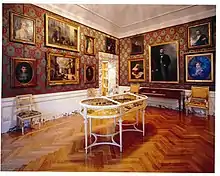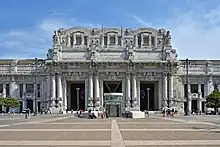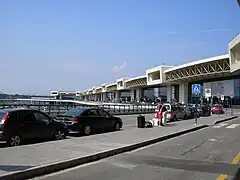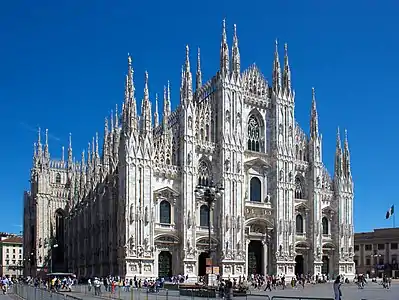
The Italian city of Milan is one of the international tourism destinations, appearing among the forty most visited cities in the world, ranking second in Italy after Rome, fifth in Europe and sixteenth in the world.[2][3] One source has 56% of international visitors to Milan are from Europe, 44% of the city's tourists are Italian, and 56% are from abroad.[1] The most important European Union markets are the United Kingdom (16%), Germany (9%) and France (6%).[1]
Tourism and statistics

According to a study, most of the visitors who come from the United States to the city go on business matters, while Chinese and Japanese tourists mainly take up the leisure segment.[1] Results from the same study also say that 60% of tourists who visit Milan are male, while 40% are female.[1] Over 58% of visitors travel by air,[1] and 26% by car.[1]
Visitors to Milan appreciate it for different reasons; for example, 65% of visitors say that public transport is efficient, while 35% say that it is expensive and inadequate.[1] Usually, tourists find that Milan has good entertainment and cultural opportunities (i.e. shopping, cuisine, music, nightlife and the arts) and that leisure activities are organized well and to a professional level.[1] Overall, the average tourist visiting Milan is satisfied by the city; over 63% say it was as they expected, 80% would want to return and 74% would advise a friend to go.[1] They also find that taxis are efficient and easy to find and that communication (i.e. advertising events and attractions) is good.[1] However, many say that there is not enough green space, that the city is very expensive and that the average level of English, as of 2009, is not very high.[1]
The number of international tourists has been steadily increasing, and as of 2015 there were around 3.21 million international arrivals.[4]
History of Milan
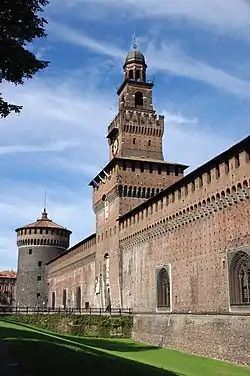
Founded around 590 BC[5] by a Celtic tribe belonging to the Insubres group and belonging to the Golasecca culture, it was conquered by the ancient Romans in 222 BC, who Latinized the name of the city into Mediolanum. The city's role as a major political centre dates back to the late antiquity, when it served as the capital of the Western Roman Empire.[6] From the 12th century until the 16th century, Milan was one of the largest European cities and a major trade and commercial centre; consequently, it became the capital of the Duchy of Milan, one of the greatest political, artistic and fashion forces in the Renaissance.[7][8] Having become one of the main centres of the Italian Enlightenment during the early modern period, the city subsequently became the industrial and financial capital of Italy.[9][10] Capital of the Napoleonic Kingdom of Italy, after the Restoration it was among the most active centres of the Risorgimento, until its entry into the unified Kingdom of Italy.
Most popular tourist attractions
The city boasts several popular tourist attractions, such as the city's Duomo and Piazza, the Teatro alla Scala, the San Siro Stadium, the Galleria Vittorio Emanuele II, the Castello Sforzesco, the Pinacoteca di Brera and the Via Montenapoleone. Most tourists visit sights such as Milan Cathedral, the Castello Sforzesco and the Teatro alla Scala, however, other main sights such as the Basilica di Sant'Ambrogio, the Navigli and the Brera district are less visited and prove to be less popular. Milan is one of the most overlooked Italian destinations, often ranking fourth or fifth on most lists of desirable Italian cities for travelers.[11] The Duomo of Milan is the city's most popular tourist destination, according to a study published in 2009.[1]
Museums in Milan
Milan has a plethora of museums, ranging from science and industry to antiquities and art. Below is a list of the main museums and permanent exhibitions in the city.
- Pinacoteca di Brera, a public gallery of art set up in the 1700s hosting works by Francesco Hayez, Andrea Mantegna, Caravaggio, Anthony van Dyck, titian, Donato Bramante and Piero della Francesca.[12]
- Museo del Novecento, a museum created in 2010 with a collection of paintings and sculptures from the first half of the 20th century. Its collection has works by italian futurists such as Umberto Boccioni, Giorgio de Chirico, Fortunato Depero. It also has works by foreign artists such as Paul Klee, Wassily Kandinsky, Pablo Picasso and Henri Matisse.[13]
- Museo Civico di Storia Naturale di Milano, a museum of natural history. It boasts a whole sperm whale skeleton and a vast collection of dioramas.
- Sforza Castle museums, which are around 6 different museums, there being the Ancient Egyptian section of the civico museo archeologico di milano, the "Achille Bertarelli" collection of prints, Museo d'Arte Antica, museo delle arti decorative, The pietà rondanini museum by Michelangelo, Pinacoteca castello Sforzesco and others.[14]
- Mudec, "the museum of cultures", a space hosting a permanent exhibition of artefacts from different cultures and many temporary exhibitions, such as one on Roy Lichtenstein during the summer of 2019[15]
Hotels and restaurants
The city also has numerous hotels, including luxurious such as Principe di Savoia and the 7 star Town House Galleria. The average stay for a tourist in the city is of 3.43 nights, while foreigners stay for longer periods of time, 77% of which stay for a 2-5 night average.[1] Of the 75% of visitors who stay in hotels, 4-star ones are the most popular (47%), while the ones which have 5-stars, or less than 3-stars represent 11% and 15% of the charts respectively. Visitors to the city, by average, find that accommodation is good, high-quality and that service is professional, however that it is also very expensive.

In addition to a unique cuisine, Milan has several world-renowned restaurants and cafés. Most of the more refined and upper-class restaurants are found in the historic centre, while the more traditional and popular ones are mainly located in the Brera and Navigli districts. Today, there is also a Nobu Japanese restaurant in Milan, which is located in Armani World in Via Manzoni and is regarded as being one of the trendiest restaurants in the city.[16] One of the city's chicest cafés or pasticcerie is the Caffè Cova, an ancient Milanese coffeehouse founded in 1817 near the Teatro alla Scala, which has also opened franchises in Hong Kong.[17] The Biffi Caffè and the Zucca in Galleria are also famous and historical ‘Caffès’ which are situated in Milan. Other restaurants in Milan include the Hotel Four Seasons restaurant, ‘La Briciola’, the Marino alla Scala and the Chandelier. Today, there are some new boutique-cafés, such as the Just Cavalli Café, owned by the luxury fashion goods brand Roberto Cavalli and the Armani Café in via Manzoni, owned by the homonymous fashion entrepreneur Giorgio Armani.
Transport

Milan is one of the key transport nodes of Italy and southern Europe. Its central railway station is Italy's second, after Rome Termini railway station, and Europe's eighth busiest.[18][19] The Malpensa, Linate and Orio al Serio airports serve the Greater Milan, the largest metropolitan area in Italy.
Azienda Trasporti Milanesi (ATM) is the Milanese municipal transport company; it operates 5 metro lines, 18 tram lines, 131 bus lines, 4 trolleybus lines, and 1 people mover line, carrying about 776 million passengers in 2018.[20] Overall the network covers nearly 1,500 km (932 mi) reaching 46 municipalities.[21] Besides public transport, ATM manages the interchange parking lots and other transport services including bike sharing and carsharing systems.[22]
Rail
Underground
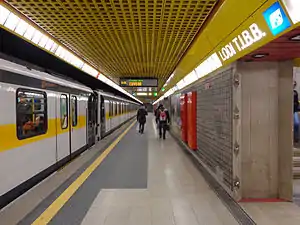
The Milan Metro is the rapid transit system serving the city and surrounding municipalities. The network consists of 5 lines, with a total network length of 104 kilometres (65 mi), and a total of 121 stations, mostly underground.[23] It has a daily ridership of 1.15 million,[24] the largest in Italy as well as one of the largest in Europe.
Suburban

As of May 2023, the Milan suburban railway service, operated by Trenord, comprised 11 S lines connecting the metropolitan area with the city centre, with possible transfers to all the metro lines. Most S lines run through the Milan Passerby railway, commonly referred to as "il Passante" and served by double-decker trains every 4/8 minutes in the central underground section.[25]
National and international trains
Milan Central station, with 110 million passengers per year, is the largest and eighth busiest railway station in Europe and the second busiest in Italy after Rome.[18] Milano Cadorna and Milano Porta Garibaldi stations are respectively the seventh and the eleventh busiest stations in Italy.[18] Since the end of 2009, two high-speed train lines link Milan to Rome, Naples and Turin, considerably shortening travel times with other major cities in Italy. Further high-speed lines are under construction towards Genoa and Verona. Milan is served by direct international trains to Nice, Marseille, Lyon, Paris, Lugano, Geneva, Bern, Basel, Zurich and Frankfurt, and by overnight sleeper services to Munich and Vienna (ÖBB).[26] Overnight services to Paris were suspended in 2020 following the COVID lockdown and subsequently discontinued.[27][28]
Milan is also the core of Lombardy's regional train network. Regional trains were operated on two different systems by LeNord (departing from Milano Cadorna) and Trenitalia (departing from Milan Centrale and Milano Porta Garibaldi). Since 2011, a new company, Trenord, operates both Trenitalia and LeNord regional trains in Lombardy, carrying over 750,000 passengers on more than 50 routes every day.[29][30]
Buses and trams
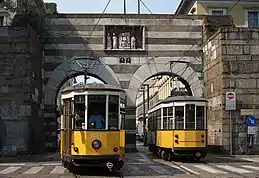
The city tram network consists of approximately 160 kilometres (99 mi) of track and 18 lines, and is Europe's most advanced light rail system.[31] Bus lines cover over 1,070 km (665 mi). Milan has also taxi services operated by private companies and licensed by the City council of Milan. The city is also a key node for the national road network, being served by all the major highways of Northern Italy. Numerous long-distance bus lines link Milan with many other cities and towns in Lombardy and throughout Italy.[32]
Cycling
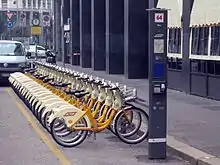
The bicycle is becoming an increasingly important mode of transportation in Milan. Since 2008, the implementation of a city-wide network of bike paths has been initiated, to fight congestion and air pollution. During the COVID pandemic in 2019, 35 km of bike lanes have been realized on short notice, to relieve pressure on the subway occupation.[33]
The bike sharing systems BikeMi has been deployed in almost all the city and enjoys increasing popularity. Stationless commercial bike and scooter sharing systems are widely available.
Aviation
In the surroundings of Milan there are three airports dedicated to normal civilian traffic (Milan-Malpensa Airport and Milan-Linate Airport, managed by SEA, and Bergamo-Orio al Serio Airport by SACBO).
Overall, the Milan airport system handles traffic of over 42 million passengers and around 700,000 tons of goods handled every year and is the first in Italy in terms of passenger volume and cargo volume. According to Assaeroporti,[34] the combined figure of the three airports with regard to passengers transported in 2022 is in fact 42,223,435, that of the two Roman airports is 32,836,515; the Milan Malpensa airport, with over 700 thousand tons, confirms the national leadership, processing 70% of the country's air cargo. [35]
- Malpensa Airport is Italy's second-busiest airport, after Leonardo da Vinci–Fiumicino Airport in Rome, with 21.3 million passengers served in 2022 and Italy's busiest for freight and cargo, handling about 700,000 tons of international freight in 2022. Malpensa airport is 9th in the world and 6th in Europe for the number of countries served with direct scheduled flights [36] It lays 45 km (28 mi) from downtown Milan and is connected to the city by the Malpensa Express railway service.[37]
- Linate Airport is Milan's city airport, less than 8 km (5 miles) from central Milan, and is mainly used for domestic and short-haul international flights. It served 7.7 million passengers in 2022 ranking as the 8th airport in Italy for passenger traffic.[38] Linate Airport is Hub of ITA together with Rome Fiumicino airport and is connected to the city centre via the M4 blue metro line.
- Orio al Serio Airport, located some 50 km (31 mi) away, near the town of Bergamo, mainly serves the low-cost traffic of Milan and it is the main base of Ryanair (13.1 million passengers served in 2022) [39] ranking as the 3rd airport in Italy for passenger traffic.
Lastly, Bresso Airfield is a general aviation airport, operated by Aero Club Milano.[40]
References
- ↑ "Milano è la seconda città più amata dai turisti in Italia dopo la capitale" (in Italian). Retrieved 1 December 2023.
- ↑ "Global Destination Cities Index 2019 di Mastercard: aumentano i turisti che scelgono l'Italia" (in Italian). Retrieved 26 March 2020.
- ↑ "Turismo". Archived from the original on 2017-11-07.
- ↑ "Cronologia di Milano dalla fondazione fino al 150 d.C." (in Italian). Retrieved 11 July 2018.
- ↑ "Quando Milano era capitale dell'Impero". Corriere della Sera. Archived from the original on 9 June 2023. Retrieved 14 September 2023.
- ↑ Scott, Tom. The City-State in Europe, 1000–1600: Hinterland, Territory, Region. OUP Oxford. p. 17.
- ↑ kuneo_Cav (20 May 2019). "Storia del ducato di Milano: dai Visconti ai Sforza". Cavalleria San Maurizio (in Italian). Archived from the original on 27 October 2021. Retrieved 27 October 2021.
- ↑ "Milan – story of a business capital of Europe". Italian Business Tips. 23 November 2018. Archived from the original on 27 October 2021. Retrieved 27 October 2021.
- ↑ "Milan | History, Population, Climate, & Facts". Encyclopedia Britannica. Archived from the original on 27 October 2021. Retrieved 27 October 2021.
- ↑ Crow, Melinda (9 September 2016). “Your Milan Must-Do List”, First Read--Travel.
- ↑ "Pinacoteca di Brera", Wikipedia, 2018-07-30, retrieved 2019-05-05
- ↑ "Museo del Novecento", Wikipedia, 2019-02-17, retrieved 2019-05-05
- ↑ "Sito Ufficiale Castello Sforzesco". www.milanocastello.it. Retrieved 2019-05-05.
- ↑ "Mudec - Museo delle Culture di Milano". Mudec (in Italian). Retrieved 2019-05-06.
- ↑ "Milan Restaurants". Worldtravelguide.net. Archived from the original on 2010-01-26. Retrieved 2010-01-22.
- ↑ "Cova Pasticceria Confetteria - dal 1817". Pasticceriacova.com. Archived from the original on 2010-03-26. Retrieved 2010-01-22.
- 1 2 3 "List of major railway stations in Italy with passenger figures". Ferrovie dello Stato. Archived from the original on 22 July 2011. Retrieved 20 September 2011.
- ↑ "Milano Centrale station official page on Ferrovie dello stato website". Ferrovie dello Stato. Archived from the original on 24 September 2011. Retrieved 20 September 2011.
- ↑ "ATM in Figures ATM, Azienda Trasporti Milanesi". www.atm.it. Archived from the original on 28 December 2017. Retrieved 10 June 2020.
- ↑ "ATM in Figures". www.atm.it. Azienda Trasporti Milanesi. Archived from the original on 28 December 2017. Retrieved 27 December 2017.
- ↑ "Carta della Mobilità 2011" (PDF). Azienda Trasporti Milanesi. Archived from the original (PDF) on 29 March 2012. Retrieved 20 September 2011.
- ↑ "L'opera che ha fatto di Milano una grande metropoli" [The work that has made a great metropolis of Milan] (in Italian). Metropolitane Milanesi SpA. Archived from the original on 13 October 2018. Retrieved 20 June 2015.
- ↑ "Atm, un piano da 524 milioni per 500mila passeggeri un più". la Repubblica. 3 September 2013. Archived from the original on 12 May 2019. Retrieved 23 September 2013.
- ↑ "The Lines▶Regional & Suburban Railway". Trenord. Archived from the original on 3 January 2018. Retrieved 27 December 2017.
- ↑ "International Destinations". Ferrovie dello Stato. Archived from the original on 11 January 2015. Retrieved 20 September 2011.
- ↑ "Paris to Venice in a day from €49". The Man in Seat Sixty-One. Retrieved 25 November 2023.
- ↑ "Thello operates final trains". International Railway Journal. 30 June 2021. Retrieved 25 November 2023.
- ↑ "Lombardia regional operator Trenord launched with €250m train tender". Railway Gazette International. 4 May 2011. Archived from the original on 28 December 2017. Retrieved 27 December 2017.
- ↑ "Trenord – Company profile". trenord.it. Archived from the original on 30 January 2019. Retrieved 30 January 2019.
- ↑ "world.nycsubway.org/Europe/Italy/Milan (Urban Trams)". World.nycsubway.org. 8 December 2003. Archived from the original on 9 March 2009. Retrieved 13 March 2009.
- ↑ "Long-Distance Buses". City of Milan. Archived from the original on 15 July 2016. Retrieved 23 July 2016.
- ↑ "La mappa delle piste ciclabili di Milano e 35 chilometri di nuovi itinerari: obiettivo raggiunto a ottobre". mentelocale.it (in Italian). 28 August 2020. Archived from the original on 5 November 2021. Retrieved 5 November 2021.
- ↑ "Statistiche Dati di Traffico Aeroportuale Italiano". Assaeroporti (in Italian). Archived from the original on 8 December 2013. Retrieved 21 February 2023.
- ↑ "Aeroporti italiani: nel 2022 passeggeri in crescita, gli scali del Sud e delle Isole guidano la ripresa del traffico verso i livelli pre-Covid". Assaeroporti (in Italian). 31 January 2023. Archived from the original on 21 February 2023. Retrieved 21 February 2023.
- ↑ Ceresa, Gabriele (15 February 2023). "Malpensa torna tra i primi 10 aeroporti al mondo per Paesi serviti con voli diretti". MALPENSA24 (in Italian). Archived from the original on 22 February 2023. Retrieved 22 February 2023.
- ↑ "Collegamento Milano Malpensa – Malpensa Express". Malpensaexpress.it. Archived from the original on 18 October 2011. Retrieved 7 November 2010.
- ↑ "Statistiche Dati di Traffico Aeroportuale Italiano". Assaeroporti (in Italian). Archived from the original on 8 December 2013. Retrieved 22 February 2023.
- ↑ "Real time flights". milanbergamoairport.it. Archived from the original on 30 November 2020. Retrieved 30 January 2019.
- ↑ "The airport: technical information". Aero Club Milano. Archived from the original on 30 December 2017. Retrieved 29 December 2017.
